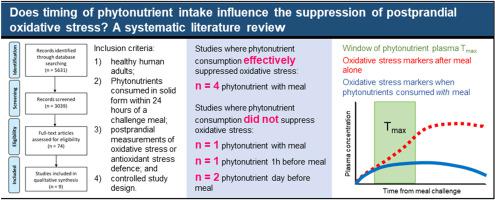Redox Biology ( IF 11.4 ) Pub Date : 2021-09-01 , DOI: 10.1016/j.redox.2021.102123 Margaret Murray 1 , Sophie Selby-Pham 2 , Beau-Luke Colton 3 , Louise Bennett 2 , Gary Williamson 3 , Aimee L Dordevic 3

|
Background
Postprandial oxidative stress markers in blood are generated transiently from various tissues and cells following high-fat and/or high-carbohydrate (HFHC) meals, and may be suppressed by certain phytonutrients, such as polyphenols and carotenoids. However, the transient presence of phytonutrients in circulation suggests that timing of consumption, relative to the meal, could be important. This systematic review investigates the effect of timing of phytonutrient intake on blood markers of postprandial oxidative processes.
Method
EMBASE, Medline, Scopus and Web of Science were searched up to December 2020. Eligible studies met the criteria: 1) healthy human adults; 2) phytonutrient(s) consumed in solid form within 24 h of a HFHC meal; 3) postprandial measurements of oxidative stress or antioxidants in blood; and 4) controlled study design. Cohen's d effect sizes were calculated to compare studies.
Results
Nine studies, involving 256 participants, were included. Phytonutrients were consumed either at the same time, 1 h before, or the day (>12 h) before a HFHC meal. Significant decreases in blood markers - plasma lipid hydroperoxides, plasma malondialdehyde, serum sNox2-dp, serum 8-iso-PGF2α, platelet p47phox phosphorylation, and Keap-1 and p47phox protein levels in mononuclear cells (MNCs) - were observed where the phytonutrient was consumed together with the challenge meal (n = 4). Lack of any effect on oxidative stress markers was observed where phytonutrients were consumed with (n = 1), 1 h before (n = 1), and the day before (n = 2) the HFHC meal.
Conclusion
Phytonutrients consumed with a HFHC meal significantly suppressed some markers of oxidative stress in blood. Although there were only a limited number of studies, it appears that suppression appeared effective at the time of peak phytonutrient concentration in plasma. However, further studies are required to confirm the observations and systematically optimise the effect of timing.
中文翻译:

植物营养素摄入时间是否会影响餐后氧化应激的抑制?系统的文献综述
背景
血液中的餐后氧化应激标记物是在高脂肪和/或高碳水化合物 (HFHC) 膳食后由各种组织和细胞瞬时产生的,并且可能被某些植物营养素(例如多酚和类胡萝卜素)抑制。然而,植物营养素在循环中的短暂存在表明,相对于膳食而言,食用时间可能很重要。本系统综述研究了植物营养素摄入时间对餐后氧化过程血液标志物的影响。
方法
EMBASE、Medline、Scopus 和 Web of Science 的检索截止日期为 2020 年 12 月。合格研究符合标准:1) 健康成年人;2) 食用 HFHC 餐后 24 小时内以固体形式消耗的植物营养素;3)餐后测量血液中的氧化应激或抗氧化剂;4)对照研究设计。计算Cohen 的d效应大小以比较研究。
结果
其中包括 9 项研究,涉及 256 名参与者。植物营养素可以在 HFHC 餐的同一时间、1 小时前或前一天(>12 小时)摄入。观察到血液标志物显着降低,包括血浆脂质氢过氧化物、血浆丙二醛、血清 sNox2-dp、血清 8-iso-PGF2α、血小板 p47 phox磷酸化以及单核细胞 (MNC) 中的 Keap-1 和 p47 phox蛋白水平。植物营养素与挑战餐一起食用(n = 4)。观察到植物营养素与 HFHC 餐同时摄入 (n = 1)、摄入前 1 小时 (n = 1) 和摄入 HFHC 餐前一天 (n = 2) 对氧化应激标志物没有任何影响。
结论
与 HFHC 膳食一起摄入的植物营养素可显着抑制血液中氧化应激的一些标志物。尽管研究数量有限,但抑制似乎在血浆植物营养素浓度达到峰值时有效。然而,还需要进一步的研究来证实观察结果并系统地优化时机的效果。



























 京公网安备 11010802027423号
京公网安备 11010802027423号